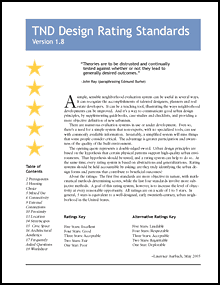
DESIGN RATING STANDARDS
TND Design Rating Standards
The Town Paper invites nominations to the TND
website list. Contact
to nominate a traditional neighborhood development (TND) website to the
list.
With several hundred developments represented on the links list, it's
necessary to have clear and consistent criteria for inclusion. There are
a few basic prerequisites:
• Only developments that have broken ground are listed. City plans are listed if they are specific, three-dimensional, and have been implemented.
• Two blocks (approximately 5 acres) and 40 dwellings is the minimum size.
• Housing in the development must be available to the public, and not entirely restricted to an age group or organization.
• Gated developments are not listed.
The Town Paper seeks websites that illustrate the principles
of traditional neighborhood design through plans, drawings, photographs
and written description and statistics. See the article "TNDs
on the Web" for information about good practice in TND website
design.

Rating Standards Guidebook
Over
the course of several years, the process of evaluating developments for
the links list has sharpened and focused my concept of what constitutes
good neighborhood design. I've applied that experience to create a formal
set of standards for rating the design of TNDs. A guidebook
for implementing the standards may be downloaded here:
TND
Design Rating Standards Version 2.2
(This link will be updated continuously as new versions are released.)
Rating Standards Tools
TND Design Rating Standards Worksheet Version 2.2
This is the Rating Standards worksheet in Excel spreadsheet format. The spreadsheet is already filled in, showing a perfect score (five stars in every category) and the default weights for each category.
When new category scores are entered, the final project score will be automatically calculated.
Rating Standards Description
Compared to the evaluation of websites for the Town Paper links list,
a formal rating is a more involved and detailed process. On-site visits
and personal experience are necessary to rate a place. Ideally, every
neighborhood on the Town Paper links list will rate at least "acceptable"
according to this rating system; however, most of the listed neighborhoods
have not been formally evaluated.
The goals of the TND Design Rating Standards are to be relatively clear
and simple, useable by anyone with a minimum amount of knowledge and training,
and to require no specialized tools such as a GIS.
The following standards are used:
1. Housing choice: Probability that any two dwellings will be different in type or size
2. Mixed use: Number of categories counted
3. Connectivity: Intersections per square mile (or square kilometer)
4. External connections: Number of entrance/exit points per foot (or meter) of perimeter length
5. Proximity: Percent of land within walking distance of town/neighborhood center, schools, parks and transit
6. Location: Evaluation of project location in the regional context
7. Streetscapes: Evaluation of overall quality of public frontages, private frontages and vehicular lanes.
8. Civic space: Evaluation of overall quality of civic space
9. Architectural aesthetics: Evaluation of overall quality of architectural exteriors
Additional Resources
• See also the article "Five Stars for Urban Design," an overview of the TND Design Rating Standards published in the American Planning Association's New Urbanism Division Newsletter, Summer, 2005 issue.
• The Belmont Bay Town Center in Woodbridge, Va., was
formally evaluated using a previous version of the design standards. The
evaluation was published in New Towns as "Belmont
Bay: Community Critique."
• The TND Design Rating Standards system is listed in the 2006 EPA compilation "Smart Growth scorecards."
• Portions of the TND Design Rating Standards are incorporated in the U.S. Green Building Council's draft LEED-ND rating system.
Comments and suggestions about the rating system and standards are welcome;
please direct your communications to
.